Source: SevenX Ventures
This article is an original creation of the SevenX research team, provided for communication and learning purposes only, and does not constitute any investment reference. If you need to quote, please indicate the source.
The original English report was published on SevenX's Mirror platform in August 2023. For more Chinese investment research content, please follow the official account [SevenXVentures].
Special thanks to Liesl and Simon from Essential, George from Flashbots, Anna and Alex from Cow Swap, and Josh from Astria for their valuable discussions, insights, and feedback on this article.
As Web3 technology gradually moves towards mass application, ensuring that users can autonomously deal with the complexity of Web3 becomes crucial. Unlike the early days of blockchain, users no longer need to decipher complex technical details. The future trend is to provide a user experience that guides and empowers users to seamlessly interact with decentralized systems. Drawing from the development history of Web2, user demands are becoming increasingly richly expressed through search engines and chatbots like ChatGPT. Web3 must provide an easy-to-use yet powerful user experience.
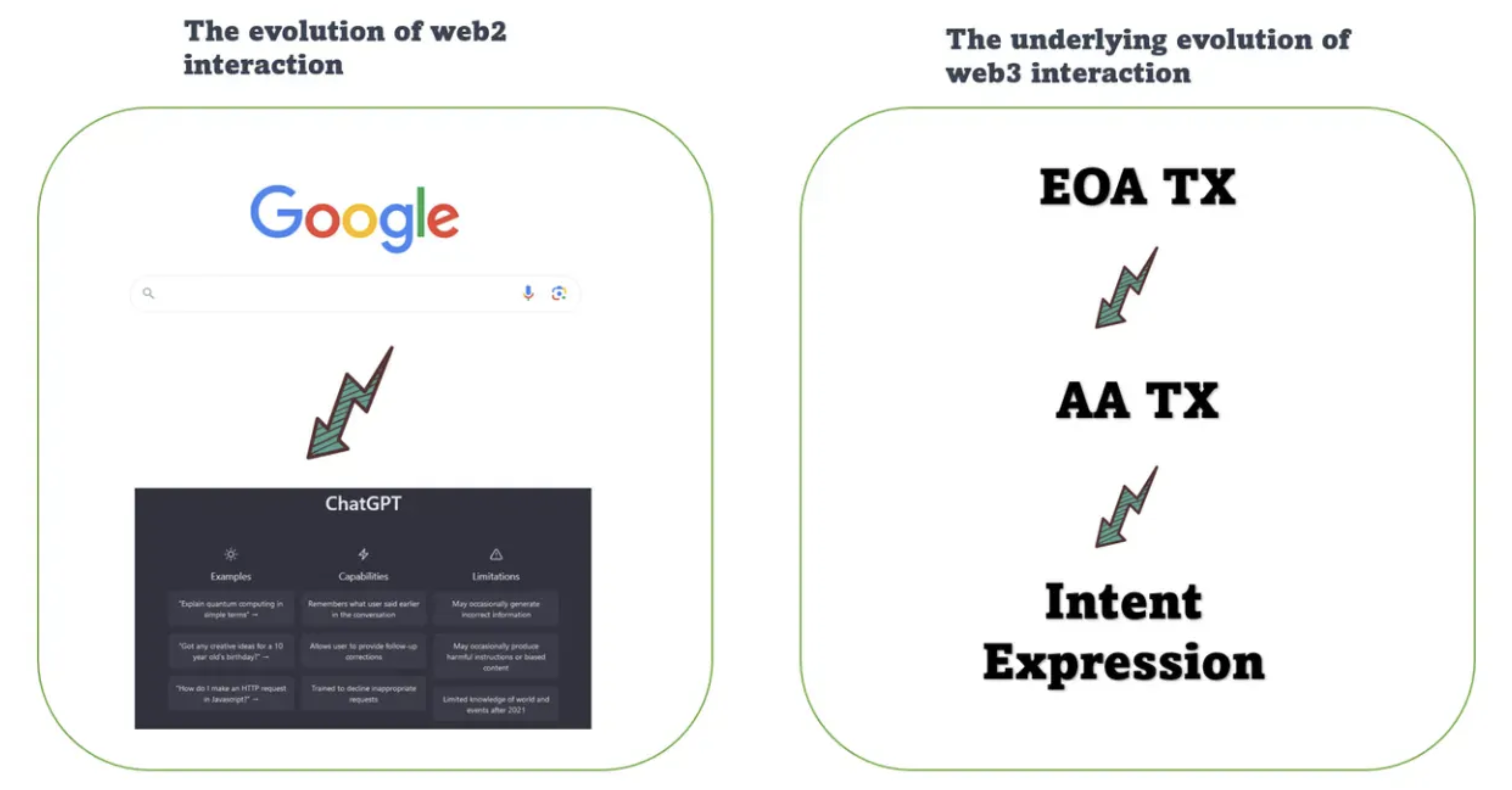
Intent-driven interaction has become the foundation of user-friendly Web3 experiences. Although there are various definitions of intent, I prefer to categorize intent into the following 3 groups of keywords:
Results, not paths: Users only need to express what they want, without needing to be concerned about the way the results are achieved.
Conditional authorization, not code authorization: When users sign blockchain transactions, they authorize the ability of the transaction code to execute arbitrary computations and modify the state of the blockchain. In contrast, when users approve an intent, they are ensuring that they authorize the release of their assets and fees after the desired results have been achieved (similar to cash on delivery in online shopping).
Competitive solvers, not trusted dapps: In a transaction-dominated world, users interact with the dapp they choose, and the dapp acts as a service provider to deliver the expected results to the users, typically like mainstream dapps such as Uniswap. In an intent-driven world, both on-chain and off-chain well-known or unknown solvers compete to achieve users' intents and receive rewards. From an economic standpoint, the more intense the competition, the higher the efficiency.
In summary, users can express their intent clearly and directly; platforms can utilize solvers and executors to find the best execution path to achieve users' goals. Just as in Web2, where black boxes work behind the scenes to optimize results, Web3 executors can use algorithms and automated processes to handle the complexity of execution, ensuring that users efficiently obtain the desired results and receive rewards.
By prioritizing user experience and focusing on expressing intent, Web3 can pioneer a new era, making the power and potential of decentralized systems accessible to everyone. The future of Web3 lies in democratically acquiring, simplifying interactions, and guiding and liberating users through a decentralized landscape to achieve a seamless user experience.
Exploring Different Types of Intent Implementation
Intents can be categorized into different types based on their generality, as shown in the following figure:
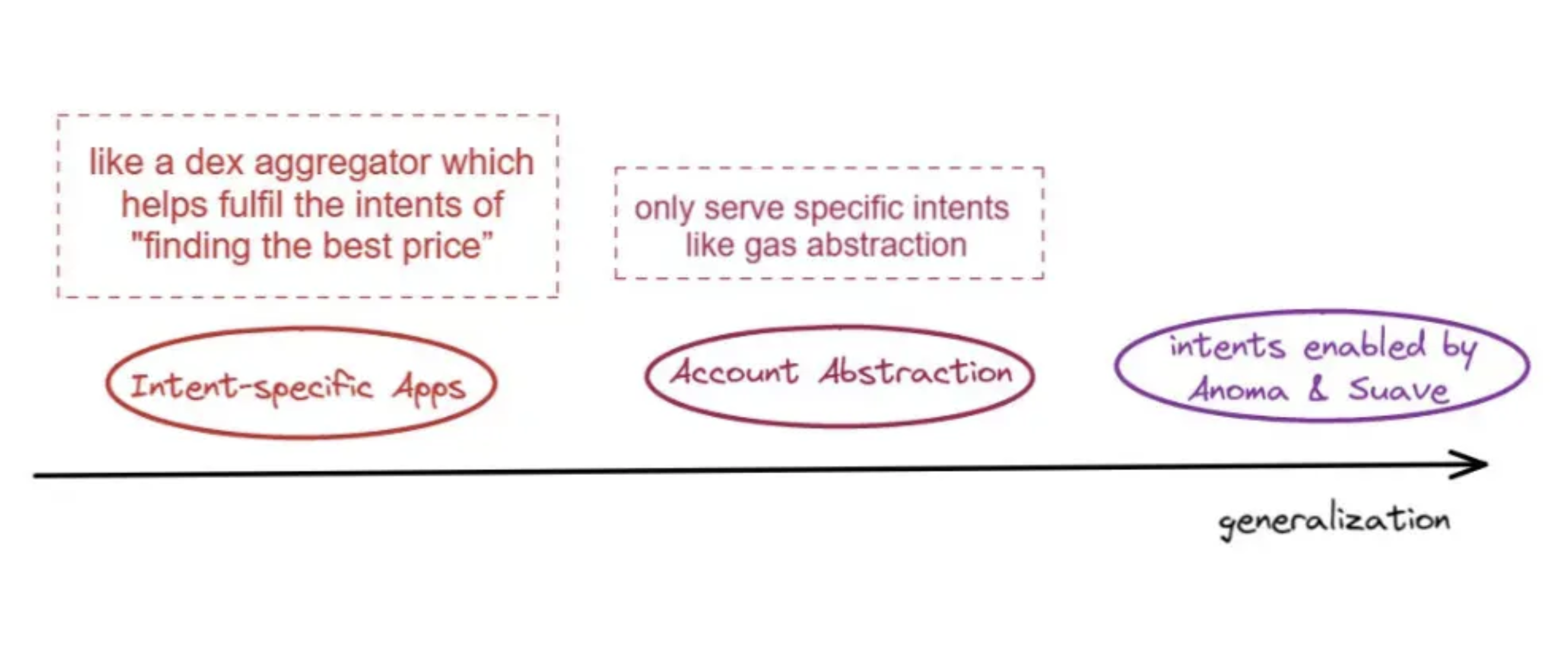
In fact, various intents are ubiquitous, as blockchain code to some extent automates and returns the expected results, extracting a certain level of complexity. However, in the future, the most universal intent is desired, as specific intent applications are not enough, and they cannot run across domains or scale as effectively as more permissionless intents like Anoma and SUAVE.
To understand how intent operates, we can analyze the current available solutions, from specific intent applications to general intent infrastructures like Anoma and SUAVE. This analysis will mainly be divided into 5 parts, focusing on different issues:
Intent expression and authorization: How users input their intent; what types and levels of intent users can express; what kind of authorization users will give?
Candidate solvers: Are they permissioned or permissionless? Are there high standards to become a solver? Are there different types of solvers focused on specific domains?
Solving process: What are the main approaches to solving problems? What determines when intent is completed?
Solver selection: What are the rules for selecting the winner from several candidate solvers? Is it winner-takes-all or a discrete competition model?
Verification and settlement: How to check if the solver has completed the task? How is settlement between users and solvers handled?
The following is a comprehensive overview of the current solutions. For more detailed information, please delve into the following content.
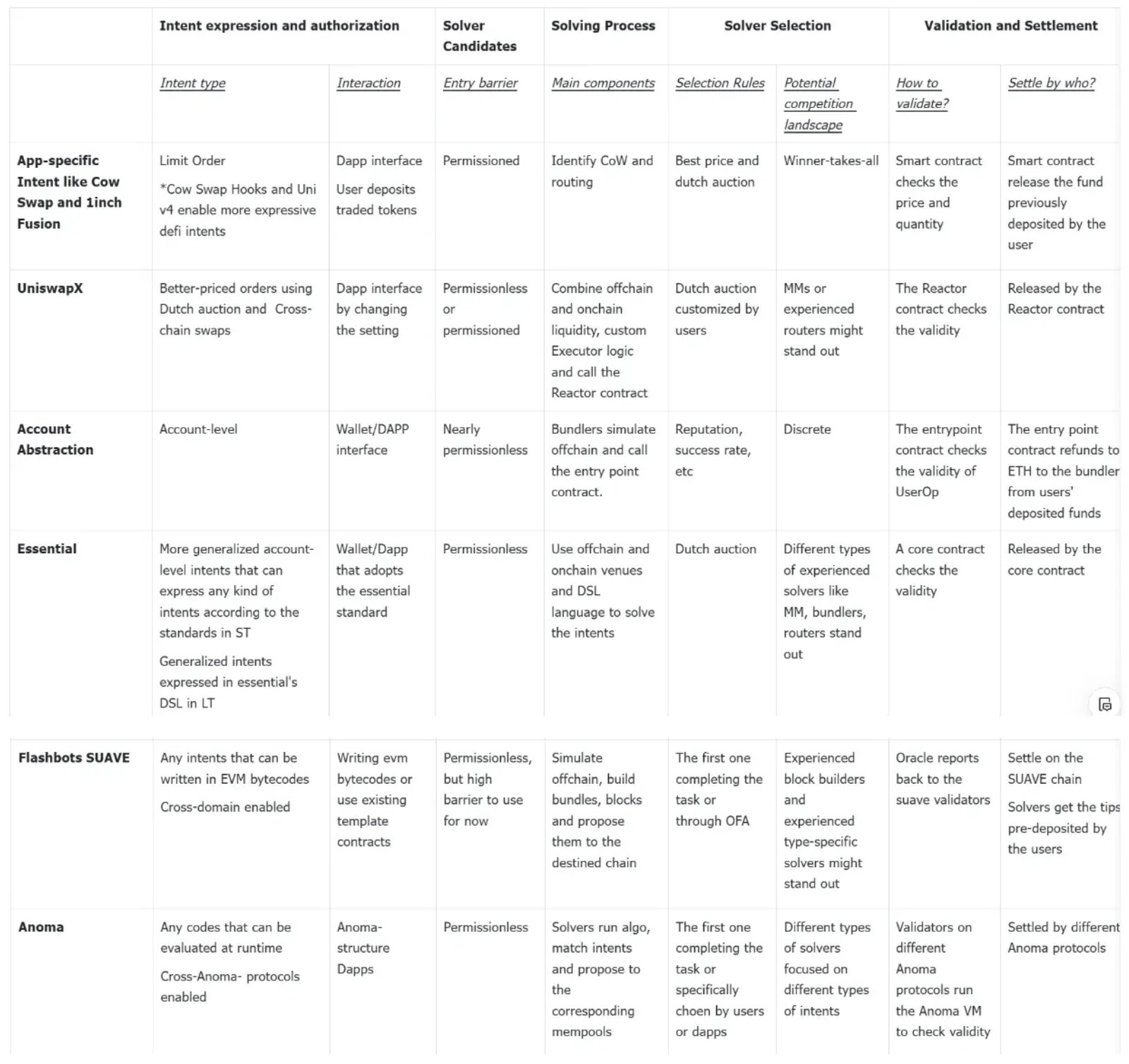
Cow Swap & 1inch fusion (limit order intent)
Intent expression and authorization
Traders on Cow Swap and 1inch Fusion platforms express their intent by interacting with the platform's interface, providing clear instructions for the desired trade or limit order.
In terms of authorization, traders sign off-chain messages or transactions to grant permission. They pay fees with transaction tokens instead of using ETH to pay gas fees, and there are no costs if the transaction is not executed.
Candidate solvers
In the case of 1inch Fusion, the solver is the resolver, operating in a permissionless manner. They need to register, undergo KYC verification, and maintain sufficient balance to pay order fees.
Cow Swap's solvers are either whitelisted by creating million-dollar binding pools (USDC & Cow), or they are included in Cow DAO binding pools or GnosisDAO binding pools and whitelisted by Cow DAO according to DAO standards.
Solving process
Solvers evaluate existing trade packages to determine any demand coincidences (CoW) that can provide the best price for executing trades or limit orders. They consider various factors such as liquidity, order book depth, and price slippage to ensure the best execution for traders.
Additionally, solvers can directly explore other potential on-chain automated market makers (AMMs) like Uniswap, or utilize DEX aggregation platforms like 1inch to discover the optimal price and path.
Solver selection
At Cow Swap, traders maximize their profits by having any external solver execute trades at the best price determined through batch auctions, where the solver providing the optimal solution is selected.
In contrast, 1inch Fusion's resolver faces more restrictions on competition and is associated with staking 1inch tokens using a Dutch auction.
Verification and Settlement
The verification and settlement process occurs after the solver executes the trade or limit order. Solvers can utilize ERC20 approvals granted to settlement contracts, representing the transfer of tokens on behalf of users. The settlement contract verifies the user's intent signature and ensures that the execution complies with specified limit prices and quantities. This verification confirms the successful completion of the expected trade or limit order.
Once verified, the settlement contract appropriately allocates funds to the participating solver and user.
Recently, Cow Swap has announced the launch of Cow Swap Hooks, enabling more general swap intents to be executed through custom-coded DeFi operations that are directly executed before and/or after the trade. It's exciting to see Uniswap v4 and Cow Swap moving towards more general intent activities, bringing us into a new world of DeFi intent!
UniswapX (Swap Intents)
The new features of UniswapX can be divided into two main parts: signing orders through Dutch auction mechanisms and cross-chain swaps.
Orders signed through Dutch auctions are similar to limit order intents on 1inch Fusion and Cow Swap, but there are differences in intent expression and authorization, candidate solvers, solver selection, and verification and settlement.
Intent Expression and Authorization
- Users have more freedom to define parameters (which may bring more complexity), including the decay function of the auction, initial Dutch order price, and more.
Candidate Solvers
- Default to permissionless mode, but users can also set it to permissioned mode.
Solver Selection
The execution price of Dutch orders depends on their block entry time. For swappers, the initial order price estimate is better than the current market price. For example, if the current market price is 1,000 USDC per ETH, the initial sell order price might be 1,050 USDC per ETH, gradually decaying until it reaches the lowest price acceptable to the swapper, such as 995 USDC per ETH. To profit, fillers are incentivized to complete orders as quickly as possible, otherwise they may miss out on the order, allowing other fillers willing to accept smaller profits to benefit.
UniswapX also supports using RFQ (allowing orders to specify a filler who has exclusive rights to fill the order within a short time) for initial Dutch auction price setting, in which case the selection process is almost the same as 1inch Fusion's auction method.
Compared to independent auctions on UniswapX and 1inch, Cow Swap is more like a batch auction, able to aggregate orders and match CoW.
Verification and Settlement
- Cross-chain swaps can be achieved through a similar process, with the main difference being the verification and settlement for achieving multi-domain swaps: solvers need to deposit more bonded assets on the original chain to ensure security and enable optimistic cross-chain protocols; an additional settlement oracle is needed to provide data for verification contracts on the original chain; UniswapX needs to deploy corresponding settlement and verification contracts in different domains.
Account Abstraction (Wallet Layer Intent)
Intent Expression and Authorization
The process begins when the wallet owner wants to perform a specific operation, typically generating a userop through a 4337 wallet interface to express their intent.
Off-chain, the wallet owner can request a bundler to handle the userop on their behalf, with limited control authorized based on intent. For example, the wallet owner can authorize the private key to conduct main account transactions, but only using the hub contract of Dapp XYZ.
Candidate Solvers
In the AA framework, bundler services are considered public goods. Most bundlers are open-source, making them non-exclusive and non-competitive, and any RPC endpoint can replicate the open-source code and operate as a bundler. Even if bundler RPC endpoints want to charge for their services, they can do so through an API key while maintaining the non-exclusivity of bundlers as public goods.
Two main types of bundlers include those tailored to meet the basic needs of wallets and provide third-party infrastructure services, and permissionless and modular bundlers.
Solving Process
Bundlers simulate the wallet's validateOp method on the userop to determine acceptance or rejection off-chain, then they send the transaction to the entry point of the AA system to invoke the handleOp method. This process also involves bundling multiple user operations together to optimize gas fees and extract MEV.
The entry point contract pushes the operation onto the chain, where chain nodes verify the operation and achieve consensus.
Solver Selection
- In the AA, the selection of solvers depends on various factors. The wallet used by the account owner may provide bundler services or use third-party infrastructure, and users may also switch RPC endpoints to choose their preferred bundler. In this case, the success rate and reputation of the bundler may influence the selection of solvers.
Verification and Settlement
- The entry point of the AA system verifies and processes on-chain operations, ensuring that userops meet requirements and security checks before executing the required operations. Once the operations are successfully executed, the entry point refunds ETH from the wallet's deposit to the bundler. This refund mechanism compensates the bundler for their work and prepayment.
Essential (Intent-Centric Account Abstraction Standard)
Currently, Essential is still in the early stages, and some descriptions and designs may evolve over time. In the short term, it will be an asset-based intent standard, similar to the erc-4337 model, but supporting more general intents and having a convenient infrastructure. In the long run, it will also provide a modular intent layer and a new constraint-based language that breaks free from the constraints of the Ethereum architecture to execute better intents.
Intent Expression and Authorization
- Dapps or wallets using the Essential standard can provide services supporting relevant intents for users and eliminate potential complexities, as users only need to interact with the interface and authorize. Intents can be expressed using the Essential standard in the short term and with its new constraint-based language for more general expression in the long term. It is compatible with EVM chains and does not require bridging funds.
Candidate Solvers
Essential supports code-expressed intents, and various solvers can join the Essential network to address corresponding types of intents, such as Cow Swap solvers for swap intents or builders for monitoring and executing chain-state-related intents.
A network of solvers will monitor and strive to fulfill these intents. Essentials is considering existing solvers or bundlers, MEV searchers, and market makers, such as those from the CoW protocol or 4337, to be part of this network.
Solving Process
- Solvers explicitly define the constraint environment they are solving for and then attempt to resolve these constraint-based intents off-chain and on-chain.
Solver Selection
- The selection process is more like a Dutch auction, where users specify constraint conditions, and solvers decide when to enter to fulfill the intent based on the extractable value. The first solver to enter and fulfill the intent will be the selected solver and may be the best solution the market can bear at that time.
Verification and Settlement
- Verification and settlement are triggered by solvers through specific on-chain smart contracts to verify and allocate fees. There will be a core contract where all solutions and intents will be submitted, and it can be extended using Essential Proofs.
Flashbots SUAVE (Multi-Domain Block-Related Intent)
Compared to the way smart contracts resolve intents in the previous examples, SUAVE uses a dedicated chain for settlement, which also serves as a messaging layer. Unlike AA and specific intent applications, SUAVE's multi-chain capability introduces an additional step of bridging funds to the SUAVE chain, enabling more cost-effective and privacy-enabled transactions.
SUAVE has just announced the launch of MEVM, a powerful modification of the Ethereum Virtual Machine (EVM) containing new precompiled contracts for executing MEV-related use cases. Through MEVM, the SUAVE chain will effectively serve MEV-related participants such as searchers, developers, and other domains seeking to capture MEV.
Intent Expression and Authorization:
SUAVE users express their intent in SUAVE by writing EVM code. These codes outline the expected outcomes and functionalities they wish to execute by defining a list of contracts allowed to access the user's confidential data. There may be some templates available for regular users.
Through MEVM, developers can deploy different types of smart contracts for specific MEV applications (e.g., OFA, block construction, etc.) or deploy new DEX types on SUAVE for other users to call.
Users bridge funds to the SUAVE chain and deposit fees.
Candidate Solvers
- The main participants serving as solvers in SUAVE may be searchers and builders. Searchers and other solvers are responsible for exploring and discovering potential solutions to fulfill user intents, while builders focus on implementing these solutions. They work together to build a robust ecosystem for fulfilling user-expressed intents. To support block-related intents in different domains, there may be many solvers with specialized skills in different domains to support different virtual machines (VMs).
Solving Process
- Solvers perform trusted and private off-chain computations, which can be used for smart contracts on SUAVE through a special precompiled contract in a TEE environment. Solvers work together to build a block containing a set of intents. The purpose of block construction is to aggregate and organize these intents into valuable blocks, which can then be proposed to the network.
Solver Selection
- In SUAVE, solver selection follows two main approaches. First, solvers that complete the expected task first are typically chosen. This enhances the efficiency and timeliness of delivering solutions. Alternatively, an order flow auction mechanism can be implemented, where solvers bid to fulfill orders, returning a portion of the order flow value to the user.
Verification and Settlement
- To ensure the validity of intents and settle transactions, SUAVE uses oracles and SUAVE validators. Oracles provide external data to verify the execution of intents, while SUAVE validators verify and settle intents on the SUAVE chain.
Anoma (Universal Intent of the Anoma Protocol)
Anoma is a universal architecture similar to Cosmos, preparing to launch the first-layer proof-of-stake (PoS) chain with IBC support. It combines intent-centric design with homogenous protocols supported by the Anoma Virtual Machine (VM) and also provides heterogeneous security features (different Anoma protocols have different consensus mechanisms).
Intent Expression and Authorization
- Users express their intent by interacting with Anoma DApps, defining the final state or properties that should be present.
Candidate Solvers
- Anoma welcomes various types of solvers, each focusing on different types of applications. These solvers monitor the mempool aligned with their interests and goals. Depending on their specific focus, they may observe all intents or a subset of intents.
Solving Process
- Solvers run solving algorithms, utilizing their expertise in interchangeable token (FT) transactions or computing rolling states, among other areas. Solvers are also responsible for matching intents. They receive intents and generate partially or fully matched transactions. Solvers determine when to match, the fee structure for partial solutions, and how to handle excess portions. Once a solver forms a fully balanced transaction, they submit it to the mempool nodes of the Anoma ecosystem.
Solver Selection
- Solver selection can be influenced by their ability to efficiently and timely complete tasks, following a "first come, first served" principle, where the first solver to complete the task is chosen.
Verification and Settlement
- Validators from different Anoma protocols run the Anoma Virtual Machine (VM) to execute and verify intents. The Anoma VM ensures the integrity and validity of intent execution by checking all relevant validity predicates (declarative smart contracts), and the allocation of funds and rewards to solvers is based on the results of executing and verifying intents using the Anoma VM.
How Intent Completely Changes Order Flow Patterns
In the current state of transaction order flow, users must navigate the execution path themselves, resulting in a relatively simple transaction order flow.
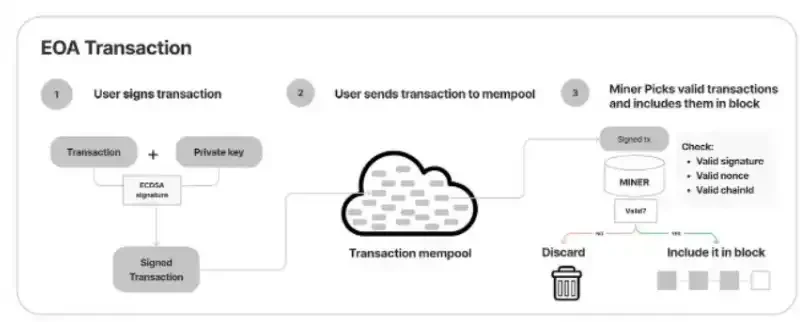
However, envisioning a future web3 ecosystem adopting an intent-centric approach, the sequence flow of intents may become more complex. In this new paradigm, users can freely express their intents and delegate the complexity to a new role - the solver.
Before delving into the details, I'd like to summarize two trends in the field of intent: first, major DApps focusing on specific types of intent, such as Uniswap and Cow Swap, are expanding intent functionality by introducing solvers. This means they are collaborating with roles (solvers) focused on solving specific problems to provide broader services. Second, more general intents require relatively new architectures, including new intent languages, new virtual machines, and more. Projects like Essential, Flashbots, and Anoma are working in this direction. This means that new technologies and tools need to be developed to meet more general intents and adapt to different types of requirements.
In this scenario, different types of intents may be handled by specific platforms or protocols. For example, transaction intents can be handled by UniswapX and Cow Swap; intents with single-domain and wallet-related features can be handled by Account Abstraction (AA) wallets or DApps and wallets compatible with Essential; while platforms like SUAVE and Anoma may handle more general and multi-domain intents.

In this new world, the order flow of intents may follow more complex paths. Let's explore a possible order flow:
User expresses intent, deposits funds, and authorizes
Intents are highly expressive; regular users may need help translating their intents into code. This can be achieved by dApps/wallets providing a user-friendly interface for this part, or there may be an aggregator providing a universal interface to express any intent, such as with the help of AI-powered Google search.
Intent sent to relevant intent mempool
Note that Anoma can have multiple mempools serving different types of intents and trusted by different DApps or protocols.
Solver conducts off-chain simulation and competes to resolve intent
In the SUAVE ecosystem, solvers have both the ability to resolve and build blocks. Some intents involve resolving cross-chain tasks by building blocks, such as cross-chain MEV operations. Skilled block builders have an advantage in building valuable blocks and completing tasks faster. Other intents may primarily require algorithmic expertise, such as optimizing liquidity aggregation across multiple chains. These intents may rely more on specific types of solvers rather than broad block-building capabilities.
In the AA ecosystem, bundlers perform simulation and bundling tasks. Then, bundled intents can be sent to the public mempool for searchers to unbundle and potentially front-run, or directly sent to trusted builders. In the early stages, small bundling may be more effective as they can be privately sent to trusted builders to avoid potential front-running. As 4337 wallets and other participants with sufficient order flow enter the market, they can operate as bundlers similar to searchers.
Verification of intent completion
There are currently various verification methods, each with its own set of trade-offs. Using smart contracts for verification, while reliable, often lacks scalability as different intents require specific verification logic and code; relying on oracles for verification introduces risks associated with oracles but provides the advantage of seamless integration with multiple chains; utilizing the Anoma Virtual Machine requires intent applications to adopt the Anoma framework but provides the ability to verify various intents.
In summary, in an intent-centric world, the order flow is different from a transaction-centric world: users sign and authorize transactions vs. users have more choices to express their intents; there are single mempools for different purposes vs. multiple mempools; dApps are responsible for execution vs. a new role of solver choosing to join and competitively solve problems; settlement on different chains vs. settlement across multiple chains (new cross-domain execution).
Ripple Effects of Intent on the Web3 World
An intent-based world involves a large number of Web3 participants. Let's take a brief look at the current landscape of intents. Please note that this is just an overview. As intents evolve, there will be more participants entering this new world. For example, shared sequencers like Astria and Espresso can provide faster pre-confirmation for multi-domain intent execution.
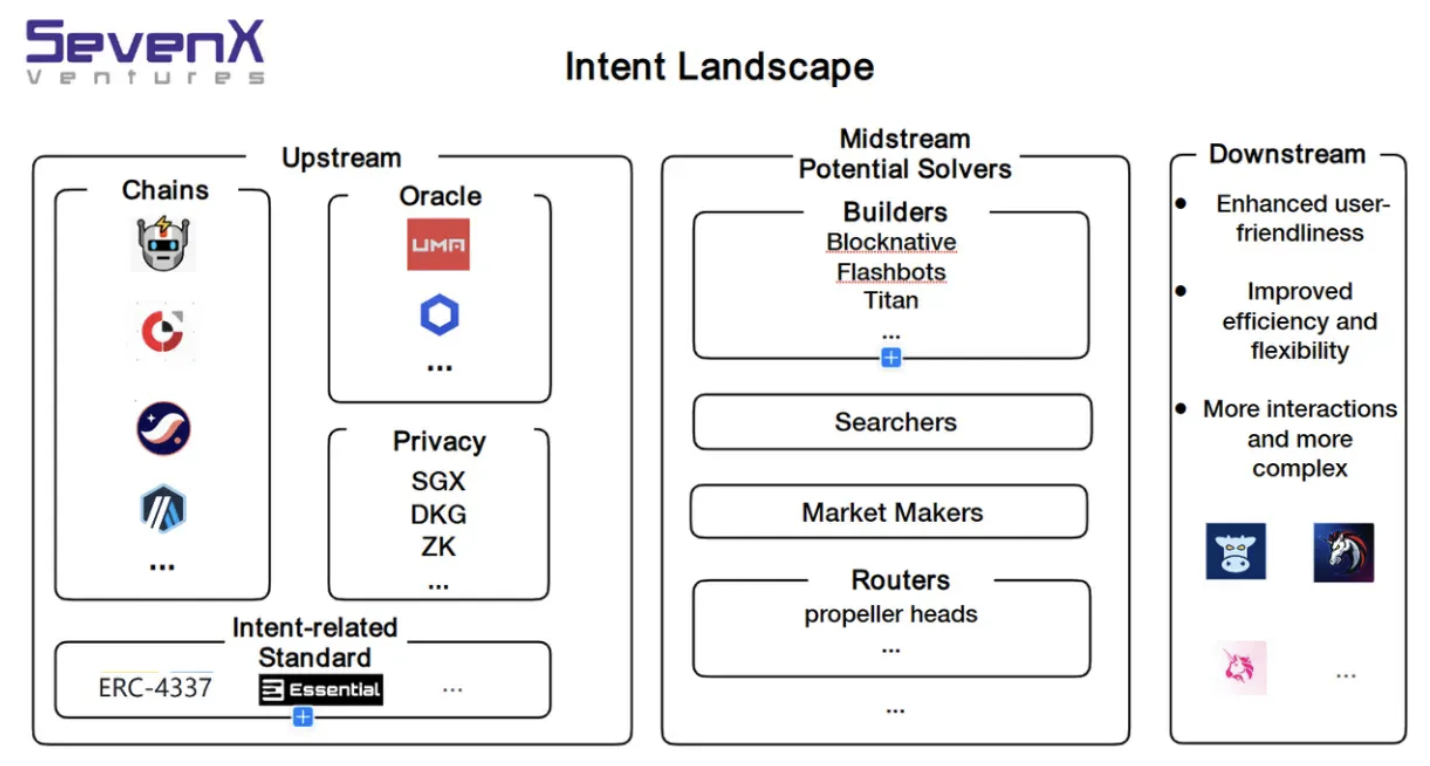
Upstream
Chains
New chains like SUAVE can enable more frequent and cost-effective intent settlements.
Anoma structured chains support new virtual machines that can efficiently and universally address intent verification issues.
L2 or more scalable chains are suitable for low-cost computations related to intent logic expression, verification, and settlement, as the expressive nature of intent itself requires significant computational resources.
Privacy
Privacy is crucial in the field of intent, as it can prevent malicious MEV issues like front-running and allow more order flow value to be bid back to users/dApps. Additionally, including privacy features can support intents requiring stronger privacy protection.
SUAVE uses SGX as a short-term solution, while Anoma supports zero-knowledge proofs (ZK) and distributed key generation (DKG) encryption.
Oracle
- Oracles now have an additional function: assisting in verifying the implementation status of intents.
Intent-Related Standards
- Universal standards help reduce fragmentation from different types of intents; solvers can more easily integrate different applications supporting intents; dApps and developers can more easily expand into the intent system. Intents also help avoid rebuilding public intent infrastructure.
Midstream (Potential Solvers)
Specific types of solvers (such as routers from CoW Swap and 1inch) and market makers have built up large liquidity networks and advanced routing algorithms, outperforming other solvers, and may directly receive exclusive orders from swappers.
Builders: Builders play an important role as solvers, especially in the final settlement process involving different chains. Experienced builders can easily fulfill this responsibility.
Searchers: Searchers have expertise in routing and advanced algorithms, making them highly valuable in solving and finding the best solutions or obtaining liquidity-related intents.
Downstream
Intent has a wide-ranging impact on various dApps - enhancing user-friendliness, enabling mass adoption, increasing multi-party participation, bringing more off-chain components, and improving efficiency and flexibility. dApps can integrate more complex functionality by integrating Intent solvers to provide more features and capabilities.
For example, in DeFi, intent can be used to execute atomicity in cross-chain environments with the help of third parties (solvers). Solvers take on the risk of failure, thus enabling a new domain of cross-chain DeFi.
Furthermore, more interactions and user commands can promote the development of complex dApps. For example, in GameFi, users now have more gameplay options:
Custom game strategies: Intent allows players to define and execute custom game strategies. They can express game objectives and actions in their own way and let solvers execute these intents within the game. This provides players with more freedom and control.
Support for economic systems: Through Intent, players can participate in in-game economic systems, such as trading game assets, providing liquidity, or participating in lending. By expressing their intent, players can perform DeFi-like financial operations within the game and receive economic rewards.
Conclusion
As I conclude this article, I notice striking similarities between the concepts of Intent and rollup: off-chain execution and on-chain final settlement and verification. With the explosive growth of the rollup ecosystem, we are now witnessing the explosive growth of Intent, making dApps increasingly expressive, with many projects developing specific Intent languages and standards.
However, I would like to draw attention to the potential centralization issues that Intent may bring. As seen in the case of private mempools and private order flows, players who can handle complex user intents and provide a more efficient and user-friendly experience may stand out, attracting more private Intent order flows, leading to better execution and attracting more order flows.
Additionally, the practical issue of how Intent players can effectively enable solvers to implement Intent for users is also a concern. For example, in the case of current small AA transactions, bundlers or builders may not have sufficient motivation to invest additional time and effort to provide new services. More expressive Intent may also face this issue.
In conclusion, the Intent field has tremendous potential and transformative power, and we must find a path forward that balances innovation, decentralization, and user empowerment. Let's embrace this exciting journey, work together, and unleash the full potential of Intent!
免责声明:本文章仅代表作者个人观点,不代表本平台的立场和观点。本文章仅供信息分享,不构成对任何人的任何投资建议。用户与作者之间的任何争议,与本平台无关。如网页中刊载的文章或图片涉及侵权,请提供相关的权利证明和身份证明发送邮件到support@aicoin.com,本平台相关工作人员将会进行核查。




